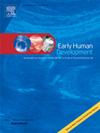Timing of initiation of therapeutic hypothermia in neonates with hypoxic ischemic encephalopathy born at a high-volume urban safety net hospital
IF 2
3区 医学
Q2 OBSTETRICS & GYNECOLOGY
引用次数: 0
Abstract
Background
Ethnic and racial disparities in neonatal outcomes have been well-documented, including higher risk of hypoxic-ischemic encephalopathy (HIE). Therapeutic hypothermia (TH) is the only approved treatment for infants with moderate to severe HIE and previous studies have shown mixed results regarding the impact of timing of initiation of TH on outcomes. These studies often include both inborn and outborn neonates and few minority patients.
Study design
This retrospective cohort study of exclusively inborn neonates from a high-volume, urban, safety net hospital (SNH) serving primarily racial/ethnic minority patients assessed the impact of timing of initiation of TH on short-term outcomes.
Results
There were 268 infants diagnosed with moderate or severe HIE from 2009 to 2023. After excluding patients for late cooling (n = 32), participation in a clinical trial (n = 41), and major comorbidities (n = 8), there were 187 patients for analysis. Similar to our neonatal population, this study cohort consisted of 94 % racial/ethnic minority patients. The average time to initiate TH was 4.4 ± 1.1 h of life (HOL) and 88 % of qualifying neonates received TH by 6 HOL. Those initiating TH at <4 HOL compared to 4–6 HOL were more likely to have severe HIE (p = 0.01). The adjusted OR for the primary outcome of in-hospital death was not associated with timing of initiation of TH [aOR = 0.75 (95 % CI 0.40–1.33); p = 0.33], nor were secondary outcomes of abnormal brain MRI or length of stay.
Conclusion
In a vulnerable population from a high-volume SNH, timing of initiation of TH was not associated with short-term outcomes.
在高容量的城市安全网医院出生的新生儿缺氧缺血性脑病的治疗性低温的开始时间
新生儿结局的种族差异已被充分证明,包括缺氧缺血性脑病(HIE)的高风险。治疗性低温(TH)是唯一被批准的治疗中至重度HIE婴儿的方法,先前的研究显示,关于开始治疗时间对结果的影响,结果好坏参半。这些研究通常包括出生和出生的新生儿和少数少数患者。研究设计:本回顾性队列研究对主要为少数种族/民族患者服务的大型城市安全网医院(SNH)的纯出生新生儿进行了研究,评估了起始时间对短期预后的影响。结果2009 - 2023年确诊为中重度HIE患儿268例。在排除了晚期冷却患者(n = 32)、参与临床试验患者(n = 41)和主要合并症患者(n = 8)后,共有187例患者进行分析。与我们的新生儿人群相似,该研究队列由94%的少数民族患者组成。启动TH的平均时间为4.4±1.1 h (HOL), 88%符合条件的新生儿在6 h内接受了TH。与4 - 6 HOL相比,开始that <;4 HOL的患者更容易发生严重的HIE (p = 0.01)。调整后的院内死亡主要结局OR与开始使用TH的时间无关[aOR = 0.75 (95% CI 0.40-1.33);p = 0.33],脑MRI异常或住院时间的次要结局也不重要。结论:在高剂量SNH的易感人群中,启动TH的时间与短期预后无关。
本文章由计算机程序翻译,如有差异,请以英文原文为准。
求助全文
约1分钟内获得全文
求助全文
来源期刊

Early human development
医学-妇产科学
CiteScore
4.40
自引率
4.00%
发文量
100
审稿时长
46 days
期刊介绍:
Established as an authoritative, highly cited voice on early human development, Early Human Development provides a unique opportunity for researchers and clinicians to bridge the communication gap between disciplines. Creating a forum for the productive exchange of ideas concerning early human growth and development, the journal publishes original research and clinical papers with particular emphasis on the continuum between fetal life and the perinatal period; aspects of postnatal growth influenced by early events; and the safeguarding of the quality of human survival.
The first comprehensive and interdisciplinary journal in this area of growing importance, Early Human Development offers pertinent contributions to the following subject areas:
Fetology; perinatology; pediatrics; growth and development; obstetrics; reproduction and fertility; epidemiology; behavioural sciences; nutrition and metabolism; teratology; neurology; brain biology; developmental psychology and screening.
 求助内容:
求助内容: 应助结果提醒方式:
应助结果提醒方式:


